
There are multiple ways to add products to your store — you can use the built-in add/edit tool to manually create products in the control panel, upload products in bulk using a CSV-formatted file, or use an app or the API to migrate your product catalog from another platform.
This guide will walk you through the different attributes that you can assign to your products on the v2 product experience, and how to create variant options and rules in the control panel and via CSV import.
Note: “v2” refers to the control panel Add/Edit product experience, not the version of the Catalog API. The v2 Catalog API has been deprecated.
If your store was created after 2019, or if you have upgraded your store to the v3 experience, see our Guide to v3 Products.
Adding a New Product
To create a new product in the control panel, go to Products › Add, or go to Products › View and click Add. You will be taken to the Details tab on the Product Edit page.
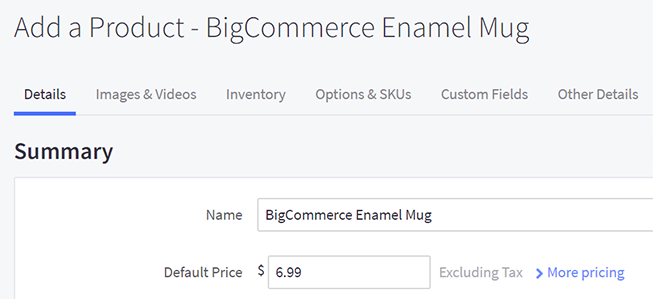
The tabs in the Product Edit page organize the different aspects of your product, including:
- Details
- Images & Videos
- Product Files (digital products)
- Inventory
- Options & SKUs
- Custom Fields
- Other Details
- Bulk Pricing
Localized Store Experiences: Sample store data, including sample products and categories, are available for all of our supported languages. For more information on the default language store setting, see Store Profile Settings
Details
The Details tab is where the most important attributes of your product are located. It is organized into the following sections:
Summary
The Summary section includes your basic product details. The required fields for creating a product are marked with an asterisk (*).
- Name* — the name of your product (maximum 250 characters; no special characters)
- Default Price* — the price of your base product, not taking into account sales, discounts, or options. Click More pricing for additional price fields. Note: Pricing changes can take up to 10 minutes to appear on the storefront. See our FAQ on price changes for more information.
- Tax Class — allows you to select the tax class a product belongs to; assigned as Default Tax Class upon product creation
- Product Tax Code — used in conjunction with automatic tax calculation
- Categories* — the categories your product belongs to. Click + to see the subcategories or Add if you need to create a new category.
- Product type — select whether your product is physical or digital
- Product code/SKU — the unique product identifier unit
- Weight* (physical products only) — your product's weight; used for shipping calculations
- Width, Height, Depth (physical products only) — your product's dimensions. While not required, you should enter your packed product's dimensions here to ensure accurate real-time shipping quotes.

More Pricing
Click More pricing to access advanced pricing options for your product.
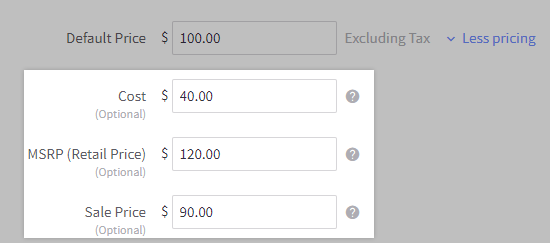
- Cost Price — the cost of your products to you; this is never shown to customers, but can be used for accounting purposes
- MSRP (Retail Price) — the price at which your distributor recommends you sell the product; this price will show next to your product's price
- Sale Price — if used, Sale Price replaces your regular product price
Description
Fill out your product description with information about your product. This section uses the WYSIWYG Editor, so you can add text, bullet points, links, or additional images and videos.

Shipping
Any shipping costs you specify here will override what you have set up in your shipping settings. If you are using ShipperHQ to provide shipping quotes at checkout, you can also assign advanced shipping rules to your product from here. These fields will only appear if you have installed ShipperHQ in your control panel.
- Free Shipping — if enabled, the product will ship for free
- Fixed Shipping Cost — the product will ship for this cost, regardless of the shopper’s shipping location
- Shipping Groups (ShipperHQ only) — assign your product to any Shipping Groups you’ve created in ShipperHQ. Use commas to separate multiple values.
- Origin Locations (ShipperHQ only) — if your products ship from multiple locations, specify its Origin Locations here. Use commas to separate multiple values.
- Dimensional Rules (ShipperHQ only) — specify how your products are packaged for shipping with Dimensional Rules. Use commas to separate multiple values.

Availability
When adding a new product, it is available for shoppers to add to their cart for purchase by default. The Availability section contains settings to modify how a product can be purchased in your store.
- This product can be purchased in my online store — the default value; allows shoppers to order the product in your store
- This product is coming soon but I want to take pre-orders — allows shoppers to place an order for your product in advance to be fulfilled later
- Message — the default value; message that will display in place of the Add to Cart button
- Release date — date you expect the product back in stock
- Remove pre-order status on this date — product will be changed back to Product can be purchased in my online store automatically on the selected date
- This product cannot be purchased in my online store — for products to be marked as catalog-only
- Show "Call for pricing" message instead of the price — the default value; field to type in your desired "Call for Pricing" message

Allow Purchases is also an updatable field when importing products. Use this if you need to enable or disable purchasability in bulk.
Images & Videos
The Images & Videos tab is where you can add visual elements to your product.
Image Requirements
- Supported file types are JPEG/JPG, GIF, WebP, and PNG. Animated TIF and PDF files are not supported.
- The optimal size for your product images is 1280 x 1280 pixels, though your theme may have different recommendations. Other product images, such as thumbnails, will be created from the original image you upload.
Adding an Image
There are multiple ways you can add an image to your product:
- Drag and drop the image from your computer to the Upload New Product Images box.
- Click Select images from your computer and navigate to the image on your computer.
- Click the Use images from the web link on the right to enter the web address of an image online.
- Click the Use images from your gallery link to select an image you've previously uploaded to the Image Manager.

Managing Product Images
Click the Use as Thumbnail radio button to select which image will represent the product.
If you have multiple images, drag and drop them up or down to change the sort order.
The image description will become the image's alt tag. This is the alternate text that provides information about the image for users who cannot view it. If the image description is left blank, the product's name becomes the image's alt tag. See our article on SEO Fields for tips on getting the most out of your image descriptions.
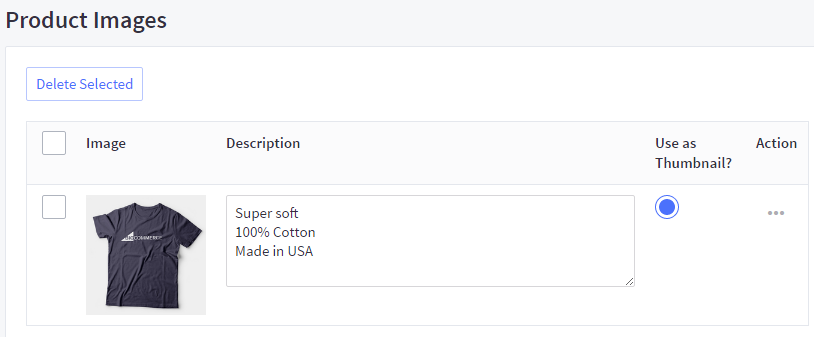
Adding a YouTube Video
Paste the link to your listed YouTube video in the text field, then click Add Video from URL. The video matching your link will appear under Video. Save your changes when done.

To remove an uploaded video, click on the Action button, then select Delete.
If a previously uploaded video is no longer available on YouTube, you will be prompted to re-add the video.

Adding a YouTube Shorts video? The link format must be changed from youtube.com/shorts/abc123 to youtube.com/watch?v=abc123 in order for it to be accepted in the URL field.
Product Files
If you are creating a digital product, the Product Files tab lets you upload the file or files you want to send to the customer when they purchase the product. Hidden by default, the tab is enabled once the Product type field is set to Downloadable product.

When you select Downloadable product, product fields that are not applicable to digital products are removed. This includes:
- Weight
- Width, Height, and Depth
- Shipping
- Inventory
- Pre-order availability (digital products cannot be pre-ordered)
On this tab, you'll see a list of attached files for the product (it will be empty by default), and a section to Upload a New File. To learn more about adding files to a digital product, see Creating Digital Products. Note that attaching a product file to a digital product is optional.
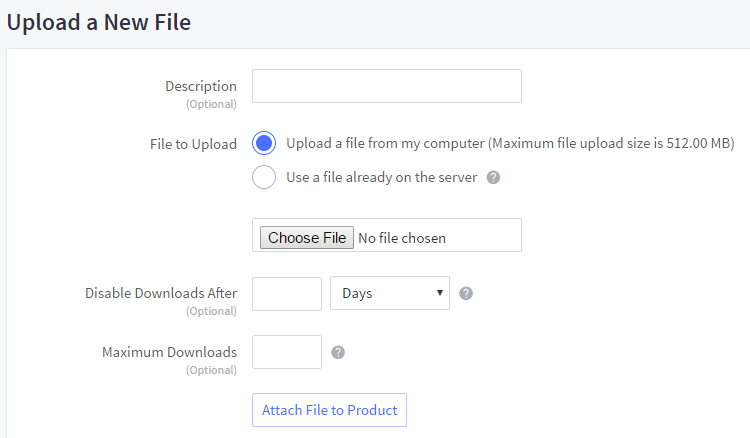
Inventory
The Inventory tab lets you set whether or not your product's inventory should be tracked, and if so, how it should be carried out. It is enabled when the Product type field is set to Physical.

- Do not track inventory for this product — inventory will not be tracked
- Track inventory for this product — your base product's stock level will be tracked
- Current Stock Level — the amount of the product currently in stock
- Low Stock Level — when your product hits this quantity, you will be sent a notification (set up in Inventory Settings)
- Track inventory by options — your product's variants will be tracked; requires adding product SKUs for each variant
For a full walkthrough on managing inventory, see Inventory Tracking.
Options & SKUs
In this tab, you can apply an option set to your product, and create SKUs and rules. See Product Options to learn more about how options and option sets work, and how to apply them to products to create variants.
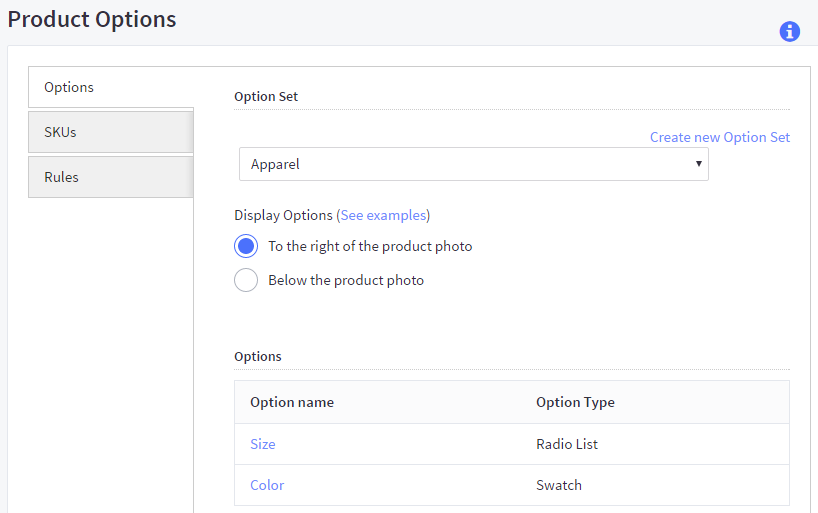
Custom Fields
Custom fields allow you to specify additional information that will appear on the products page, such as a book's ISBN or a DVD's release date. The location of these fields on your product page may differ depending on your theme.
Custom fields appear automatically in the product's details if they are defined on the product. If you don't want to show any custom fields, simply remove them from the product.
To add custom fields to your product, go to the Custom Fields tab and enter a field name and field value, such as “Material” and “Cotton”. Note that custom field names and values are limited to 250 characters each. Click + to enter additional custom fields or - to delete existing ones.

Custom fields can also be created and edited via CSV import and the API.
Other Details
The Other Details tab is where you can set various product-related fields and settings, including related products, and SEO and Facebook Open Graph settings. It is organized into the following sections:
- Product Identifiers
- Related Products
- Other Details
- Search Engine Optimization
- Facebook Open Graph (OG) Settings
Product Identifiers
This section lets you specify product identifiers, which you may need for accounting, inventory, or marketplace channel integrations. The following identifiers can be added to your product:
- Global Trade Item Number (GTIN)
- Manufacturer Part Number (MPN)
- Brand
- UPC/EAN
Related Products
Using the Related Products section will allow you to manually select which products appear in the "Related Products" panel on your product page.

For a walkthrough on setting up Related Products, see Product Panels.
Other Details
This section consists of optional product-related details that pertain to different aspects of product management. These details will generally appear on your product page under additional tabs, like Warranty Information.
- Bin Picking Number — if your product is stored in a warehouse, use this to specify where in the warehouse it can be located. This information will appear on packing slips. If your product has options, you should assign BPNs for your individual SKUs rather than the base product.
- Warranty — include any product warranty information in this section. It can also be repurposed for additional text.
- Template layout file — if you have custom product HTML templates, use this to select one other than the default (product.html)
- Search Keywords — product keywords to assist in your store's search. See Configuring Store Search for more information.
- Availability — include any details on how quickly your product ships. You may enter up to 250 characters.
- Visible — toggle the product's visibility in your store. This can also be managed from Products › View.
- Featured Products — toggle whether the product should appear in the Featured Products panel. This can also be managed from Products › View.
- Gift Wrapping — enable customers to ask that the product be gift wrapped, and specify if you want to limit the gift wrapping options available to shoppers
- Sort Order — select where you want this product to appear relative to other products (products with a lower sort order will display further up on the page). Sort orders can be negative, but must be whole numbers. See Sort Order for more details.
- Product Condition — mark whether your product is New, Used, or Refurbished. Check the box to display the condition on the product page. Consider using a custom field if you need more specificity in describing the product's condition.
- Minimum and Maximum Purchase Quantity — limit your customers to purchasing a minimum and maximum quantity of the product.
Search Engine Optimization
These settings allow you to set specific SEO-related information on your product's page. If left blank, these fields will default to what you have set in your homepage SEO fields.
- Page Title — the title shown in the web browser, as well as the main link text in search engines
- Meta Keywords — keywords relevant to the product. Separate multiple keywords by commas. Note that keywords are ignored by modern search engines.
- Meta Description — a short sentence (150-160 characters) summarizing the content of the product. This can be shown in the search engine results, although some search engines will instead show other content from the page that better matches the user's search query.
- Product URL — the actual URL of your product, automatically generated using your URL structure settings. If you are receiving any warnings about special characters in your product name causing issues with the URL, check this setting and clear out any special characters such as an ampersand (&) or percentage sign (%).
Facebook Open Graph (OG) Settings
Facebook Open Graph (OG) settings are used to provide alternative data when a product is linked inside of Facebook. See Facebook Open Graph Settings to learn more about these settings.
Bulk Pricing
To encourage shoppers to purchase more products and in higher quantities, merchants will often offer quantity discounts on certain products, also known as bulk pricing. Bulk pricing involves offering a particular item or group of items at a lower price based on the number ordered. This is particularly useful to wholesalers and merchants who sell items that are typically bought in bulk.
You can offer bulk pricing for both individual products using bulk pricing rules, and for whole categories of products (including multiple categories) using automatic promotions. You can add up to 50 bulk pricing rules per product.
To create bulk pricing rules for a single product, go to the Bulk Pricing tab. Specify the minimum and maximum quantity range for your rule, select the type of bulk discount you wish to offer ($ discount, percentage, or fixed price), and enter the discount amount. Click + to enter additional bulk pricing rules, or - to delete existing ones.

Did you know? You can use an asterisk (*) character as a wildcard quantity value. For example, a rule that begins Purchases between 10 and * of this product... would apply to any quantity 10 or higher.
FAQ
How do I write product descriptions that help drive traffic and sell products?
See SEO Fields for tips and tricks for writing effective product descriptions and utilizing keywords.
Why am I getting the error "Only letters, numbers, dots (.), dashes (-), underscores (_) and backslashes (/) are allowed in URLs"?
This issue can happen when product URLs contain special characters, or if common characters such as a space or "&" are converted into URL format. If this happens, edit the product and go to the Other Details tab. Find the Product URL field under the Search Engine Optimization section and click Reset, then try saving the product again.
If you have several products affected by this issue, consider exporting your products, performing a find/replace function to fix any special characters, then re-importing.
How can I adjust how my product images appear?
Check out our guide to Adjusting Your Store Image Settings or review your theme's documentation for more information on optimizing your product images for your specific theme.
Can I add videos directly to my product description?
Yes, use the YouTube button in the WYSIWYG editor.
Can I assign bulk pricing to products using a CSV import file?
No, bulk pricing rules cannot be created via CSV import. However, you can assign bulk pricing via the API.
Can I set bulk pricing for variants?
Variant-level bulk pricing is possible using Price Lists.
Can I add customs information to products, such as country of origin, commodity description, and HS codes?
When using the v2 Products experience, this information can only be added by using the API. The v3 Products experience supports this feature in the control panel, as well as via API.
In the next chapter, we’ll discuss how to create product options, the different option types available in the v2 Products experience, and the rules that can be applied to them.


